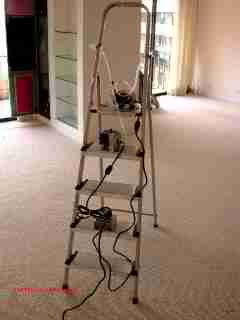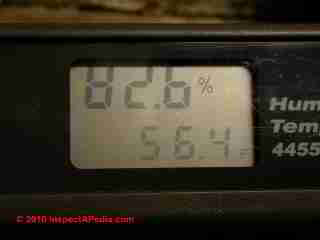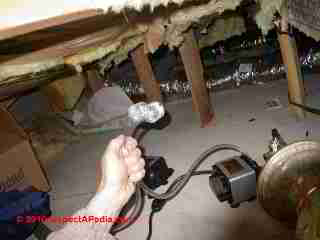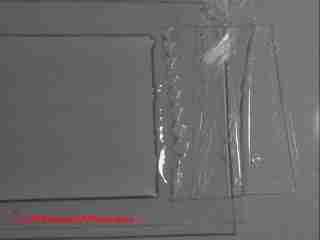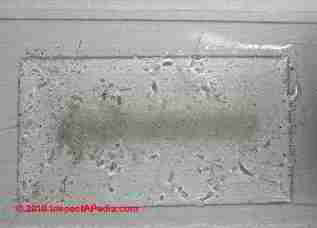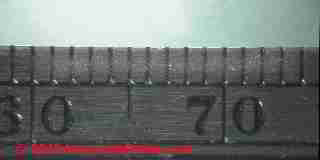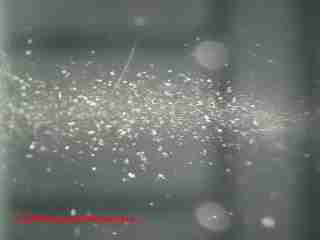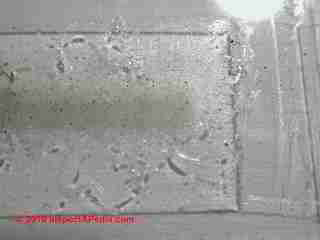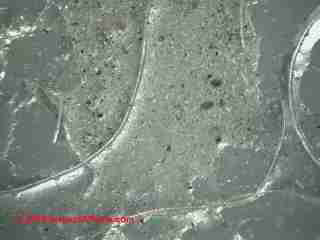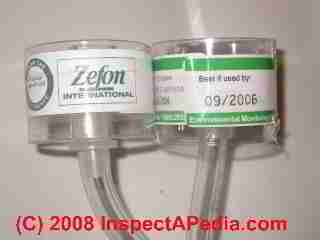 Popular Air Sampling Cassette Comparison
by Practical Field Tests
Popular Air Sampling Cassette Comparison
by Practical Field Tests
- POST a QUESTION or COMMENT about the consistency of air sampling cassettes for airborne particle collection such as tests for mold, fiberglass, building dust samples, vacuum samples of building cavities, carpets, insulation, etc.
Spore trap reliability for indoor air sampling: how accurate & consistent are air sampling cassetts for airborne mold, dust or other particle testing?
Air sampling cassette tests for mold: accuracy and consistency comparison: this practical air sampling field study performed side-by-side comparisons of two popular air sampling cassettes in order to report on similarities and differences between the two products and their field or laboratory performance characteristics.
InspectAPedia tolerates no conflicts of interest. We have no relationship with advertisers, products, or services discussed at this website.
- Daniel Friedman, Publisher/Editor/Author - See WHO ARE WE?
A Field Comparison of Air-O-Cell and Allergenco-D Air Sampling Cassettes
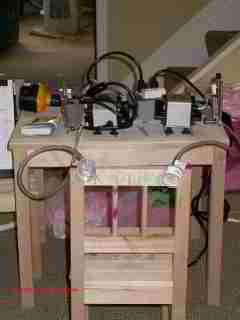 This article is the first of two discussions on variability in air sampling cassette test results and particle trace patterns. This article describes and present photographs of measurements of particle traces produced by the Air-O-Cell® and Allergenco-D® sampling cassettes when air samples using the two cassettes were collected simultaneously.
This article is the first of two discussions on variability in air sampling cassette test results and particle trace patterns. This article describes and present photographs of measurements of particle traces produced by the Air-O-Cell® and Allergenco-D® sampling cassettes when air samples using the two cassettes were collected simultaneously.
A separate quantitative analysis reporting and comparing actual particle counts forms part two of this topic and remains to be completed. Those results will also be provided here.
Field test comparisons of Air-O-Cell® vs Allergenco-D® Air Sampling Cassettes
Article Contents
- AIR SAMPLING CASSETTE STUDY OBJECTIVES & brands / designes compared
- AIR SAMPLING CASSETTE FIELD TESTING APPARATUS
- AIR SAMPLING CASSETTE FIELD TESTING PROCEDURE
- VARIATIONS IN AIR SAMPLING CASSETTE PARTICLE TRACE DIMENSIONS
- PRACTICAL & OPERATING DETAILS for Air-O-Cell and Allergenco-D Air Sampling Cassettes
- COMPARISON OF PARTICLE TRACES on Air-O-Cell and Allergenco-D Air Sampling Cassettes
- AIR SAMPLING CASSETTE CAPTURE MEDIA CONSISTENCY
- AIR SAMPLING CASSETTES AND MEDIA SHELF LIFE
- CONCLUSIONS: AIR SAMPLING CASSETTE CONSISTENCY & PERFORMANCE
This study was conducted and financed by InspectAPedia.com. No financial support was provided by any third party, but an air sampling pump and a supply of Allergenco-D air sampling cassettes were provided by Environmental Monitoring Systems who have reviewed this article and who comment that since the original study of their A1-D cassettes described here, product design and quality control improvement have been continuing.
More information about product changes appear in notes included in the article below. Comments from Air-O-Cell or Zefon Corp. have not been received. [Note: peer reviews of articles found here may have provided technical corrections or suggestions but do not indicate reviewers' agreement or disagreement with the article or its conclusions.] Comments or critique are invited - CONTACT us.
Airborne Particle Sampling Cassette Study Objectives
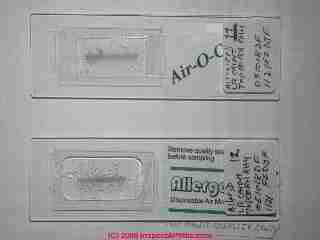 The purpose of this field study was to observe similarities and differences between the field performance of two popular air sampling cassettes, the Air-O-Cell® cassette distributed by Zefon International, and the Allergenco-D® Cassette distributed by Environmental .
The purpose of this field study was to observe similarities and differences between the field performance of two popular air sampling cassettes, the Air-O-Cell® cassette distributed by Zefon International, and the Allergenco-D® Cassette distributed by Environmental .
Sampling cassettes were mounted to face in the same location, oriented in the same direction and same floor height, and they collected the same volume of air simultaneously, using identical and calibrated air sampling pumps operating at the same airflow rate.
The cassettes were separated horizontally to avoid possible airflow interference between the two devices.
Examples of our field testing apparatus and controls are shown below.
Air Sampling Cassettes
The Allergenco-D® Sampling Cassette is described by EMS-Sales as:
The AllergencoD™ sampling cassette is an inertial impactor utilizing kinetic energy to impinge airborne particulate into an adhesive media.
This type of impactor employs the use of a nozzle (or venturi) to accelerate air onto an adhesive coated glass substrate.
The glass substrate is subsequently removed and the impaction zone (or trace) is then studied for quantitative analysis. The AllergencoD™ contains a laminar flow venturi (US patent#7,051,605) which directs airborne particles perpendicular to the plane of impaction. This creates a more well defined impaction trace resulting in more efficient collection and quantitative analysis.
The Air-O-Cell Sampling Cassette is described by Zefon International as:
The Air-O-Cell® is a unique air sampling cassette specifically designed for the rapid collection of a wide range of airborne aerosols including mold spores, pollen, insect parts, skin cell fragments, fibers (e.g. asbestos, fiberglass, cellulose, clothing fibers, etc.) and inorganic particulate e.g. ceramic, fly ash, copy toner, etc.). The Air-O-Cell® collects both viable and non-viable sample specimens, providing a much broader overview of potential allergens contaminants than conventional sampling techniques.
The Air-O-Cell® operates upon the principle of inertial impaction.
Particulate laden air is accelerated as it is drawn through the cassettes tapered inlet slit and directed towards a small slide containing the collection media, where the particles become impacted, and the air flow continues out the exit orfice.
The adhesive nature of the collection media prevents the collected particulate from blurring or being washed off during the laboratory staining process, and eliminates sample loss from vibration during handling and shipment.
Air Sampling Cassette Field Testing Apparatus
Our parallel air sample collection apparatus set-up is shown below-left in use in the Watergate building in Washington, D.C. in November 2005. Other air sampling cassette tests were conducted in New Jersey and New York in 2005 and 2006. At below right is a similar test conducted in New York.
The air sampling pumps included a built-in flow-meter that was first calibrated in our laboratory using a standardized bubble chamber. In the field each pump was adjusted to the same air flow rate - 15 lpm.
A common timer-controller (seen on the bottom of the stepladder above, and between the two air pumps (below) controlled the sampling interval so that we could assure that the two pumps were operated simultaneously and for an identical pumping interval.
We also established and recorded site conditions likely to affect any air sampling measurement results, including
- The establishment of still-air conditions no less than two hours before the samples were collected
- Building HVAC systems were shut down before, during, and after the sample collection
- No fans were in operation
- Windows and doors were shut, including interior doors between rooms
- No personnel were in the test area before or during the sample interval except for the test operator
- Air sampling cassettes were aimed in the same direction
- Air sampling cassettes were placed at the same floor-height
- Air sampling cassettes were experimentally separated by distances ranging from touching-cassettes [image above] to four feet apart. We experimented with different cassette separation differences but did not observe a significant effect.
As a rule we kept the cassettes 24" apart. We did not use cassette horizontal separation of more than 36" because of the importance of sampling the same indoor air and indoor air conditions.
Our opinion is that if separated by 12" or more (such as the chair back in our photo at above right), there will be no air pattern interference between the sampling cassettes in a simultaneous measurement. - The air sampling cassettes were connected and used according to their manufacturer's protocols for equipment connections, tubing, flow rates, sampling interval, and ambient temperature.
- On the date of use, the air sampling cassettes from each of the manufacturers were confirmed as not having reached their marked expiration date. (The airborne particle collection rate may change with out-dated air sampling cassettes if the media has become dried.)
- In the laboratory the samples were prepared using the manufacturer's recommendations.
Some tests were conducted in duplicate, except that a second sample pair was collected after making a single "wave" of a clipboard at surfaces near the sampling equipment to stir up local, previously-settled dust.
Other Air Samplers Operated in Parallel
Some tests included operation of other air sampling devices during the test interval, for other and calibrating data comparisons, including
- The Burkard personal air sampler (10 lpm, maximum 9 minute sample interval)
- The Allergenco Time-Lapse impaction sampler

In our photograph of a sampling cassette test underway in Rhinebeck, NY you can see our Burkard personal air sampler at the left, and two sampling cassettes suspended over a workbench, facing, separated by 36", and placed 18" distant from moldy oriented strand board paneling in a 1930's poured concrete basement.
Indoor and outdoor temperature and relative humidity were also recorded, as well as the usual visual site observations and case history associated with building indoor air quality investigations.
Air Sampling Cassette Field Testing Procedure

Our photograph (left) shows air sampling cassette particle trace slides that have been mounted onto microscope slides for both an Air-O-Cel air sampling cassette (top of photo) and an Allergenco-D air sampling cassette (bottom of photo).
The sampling media gel size and thickness appear similar for the two products. The square versus rounded corner sample collection media deposits is visually obvious but makes no practical difference in usage since the particle trace does not extend close to the edges of the media.
Using duplicate air sampling pumps lab and field calibrated to collect uniform simultaneous air samples, two samplers were operated in parallel, switched on and off by a common timer to sample indoor air particles in indoor locations at seven different buildings in 2005-2006.
The manufacturers' standard particle trace dimensions expected to be produced by each air sampling cassette are provided below.
| Nominal air sampling cassette specifications | |||
|---|---|---|---|
| Bioaerosol Sampling Cassette | Trace Specifications | Operational Protocol Flow Rates | Operational Protocol Time |
| Allergenco-D® Sampling Cassettes | 1.1 mm x 14.4 mm 1.1 mm x 14.0 mm |
5-20 lpm 15 lpm standard |
1-20 minutes |
| Air-O-Cell® Sampling Cassettes | 1.1 mm x 14.4 mm | 15 lpm standard | 0.5 - 10 min |
| Comments | We observed in field practice that trace dimensions vary from nominal depending on dust conditions and sampling interval. |
Optimal flow rate is 15 lpm. At higher rates expect reduced capture |
Adjust sampling interval for Do not overload slides |
Variations in Air Sampling Cassette Particle Trace Dimensions
The actual particle trace in an individual air or vacuum dust sample may vary from the official trace dimensions, depending on several variables:
The airflow rate of the sampling pump and its deviation from the manufacturer's recommended flow rate, including any effects of extraneous forces such as use of a long connecting tube between the sampling pump and cassette, effect off battery condition on some battery-operated pumps, duration of the sampling interval, level of airborne dust and debris in the sample area, type and size of airborne particles in the sample area, local air currents in the sample area due to open windows, wind, operation of overhead fans, operation of HVAC equipment, and the orientation of the air sampling cassette with respect to these air currents.
To control for these variables all of our test samples were collected indoors, in still-air conditions (no fans or HVAC equipment operating for at least two hours before the sample collection), windows and doors shut, no people in the sample area other than the experimenter.
Practical & Operating Details for Air-O-Cell and Allergenco-D Air Sampling Cassettes
Practical Considerations in Mounting Air Sampling Cassettes onto Microscope Slides
In each air sampling cassette, a thin glass cover slip has been coated with a patented sample collection media and affixed into position below the air venturi slot in the cassette inlet side.
To prepare an air sample for microscopic examination the cassette must be opened by cutting a paper or plastic tape that seals the edges of its mating halves, and the media-coated cover slip, now containing a particle trace, is gently removed and transferred to a microscope slide for mounting, hydrating with an appropriate liquid, application of a larger cover-slip to cover the particle trace, and subsequent analysis.

Our photograph (left) shows air sampling cassette particle trace slides that have been mounted onto microscope slides for both an Air-O-Cel air sampling cassette (top of photo) and an Allergenco-D air sampling cassette (bottom of photo).
The sampling media gel size and thickness appear similar for the two products. The square versus rounded corner sample collection media deposits is visually obvious but makes no practical difference in usage since the particle trace does not extend close to the edges of the media.
(Product Update Note by EMS: Since the manufacture of these Allergenco-D cassettes in 2005, product development at EMS has continued. Nine modifications to improve collection efficiency and/or manufacturing quality control have been implemented, including the elimination of die cut adhesives. Current production uses square cut polymentic adhesive.)
Mounting the Particle Trace Micro-Slide onto a Microscope Slide
When affixing the Air-O-Cel micro-slide onto the microscope slide, while it is possible to allow the trace to "free float" on the receiving microscope slide pending addition of a hydrating solution (typically Triacetin 98%), in order to keep the trace micro-slide squarely positioned on the receiving microscope slide, some practitioners teach the practice of using a small square of clear adhesive tape at each end of the micro-slide to secure it squarely on the microscope slide. (J. Shane, previously at McCrone Research - DF).
Above and continuing below, we demonstrate using clear adhesive tape to secure an Air-O-Cell particle trace in place onto the microscope slide.
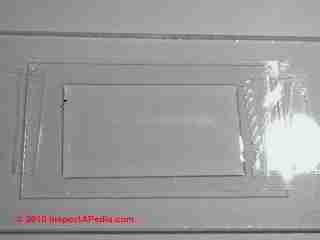
On removing each particle trace micro-slide from its cassette we found that a small dab of adhesive remained on the under-side of the Allergenco trace micro-slide. That material assisted in fixing the micro-slide in position onto our standard pre-cleaned microscope slide. Below we demonstrate using the cassette-mounting adhesive left on the back of the micro-slide to secure an Allergenco-D particle trace in place on the microscope slide.
This is easier and faster than the "adhesive tape" method described above.
The air space between the under-side of the micro-slide and the microscope slide was not appreciably different between the two approaches, and in either approach, our triacetin fluid could easily be made to flow between the two glass planes where added optical precision was desired.
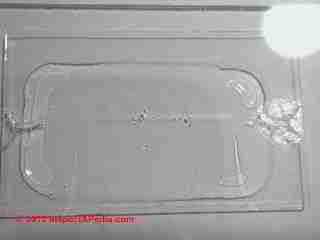
Choices of Mountant for Air Sampling Cassette Coated Glass Slides
For mounting the coated glass slide made by Allergenco, Tucker recommends (but does not require) preparing the sample with Lactophenol cotton blue stain.
(Note courtesy of EMS: Recently, ASTM Method D7391-09 Standard Test Method for Categorization and Quantification of Airborne Fungal Structures in an Inertial Impaction Sample by Optical Microscopy has been published to standardize the analysis of Inertial Impaction Samplers. This method allows for stains and non-stain optical fluids.)
OPINION: However experienced aerobiologists often prefer very light stains or no stain color at all in order to preserve the natural color of some particles that can aid in their identification. Also we have observed that slides prepared with lactophenol, despite the presence of a phenolic preservative (also a carcinogen), slides often become opaque in long term storage. We prefer using triacetin which works well with this media.
Cassette Sample Preparation Particle Float Warning
Experts also warn that improper placement of mounting fluid on the slide can "wash" away loose particles, causing a significant interference with accuracy of any particle counts attempted.
OPINION: A warning sign that this error has occurred might be the observation of particles and debris that washed to the edge of a microscope slide cover slip, or the observation of many particles floating and moving in the mounting fluid. While quantitative analysis should not be attempted when this error condition has been observed, we did not find that the particle float problem was any more frequent with one of our test sampling cassette brands than the other.
Comparison of Particle Traces on Air-O-Cell and Allergenco-D Air Sampling Cassettes
Here we show a closeup of the air sampling cassette collection media and particle trace for an Air-O-Cell cassette (above) and an Allergenco-D cassette (below). These were heavy traces collected for photographic clarity.
Watch out: For actual building air sampling these example traces have been overloaded.

Particle Trace Length
If actual particle trace dimensions vary much from the manufacturer's standard trace dimensions the effect will be an inaccuracy in computed particle frequency calculations for laboratories that do not count 100% of the particle trace.
Even when 100% of a particle trace is counted, variations in microscope and slide preparation, calibration, and human error will produce some variation in actual counts obtained.
An Air-O-Cell particle trace is shown above, and an Allergenco-D particle trace is shown below.
You can see that the Allergenco-D trace in this sample was 14mm in length and pointed in end-shape, and the Air-O-Cell trace was 13.5mm in length and more square in end-shape.
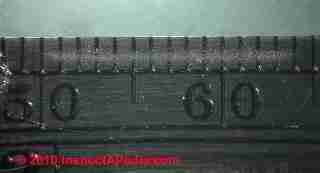
OPINION: We observed that variations in particle trace length and width occurred but that they depended on the indoor dust conditions or airborne particle levels in the test area, combined with sampling interval and location far more significantly than any variation in particle trace dimensions between the two sampling cassette brands tested.
Air Sampling Cassette Actual Particle Trace Width in Field Use
Both particle traces were nominally 1mm in width, but the Allergenco-D trace (below-left) appeared to be less uniform near the trace ends and in some of our samples the trace was thinner, and more scattered near its edges than the Air-O-Cell trace in some individual samples.
The two samples were collected simultaneously, in the same location, and represent an air sample of 105L obtained at 15 LPM using EMS Megalite pumps. The photograph at below-left has been enlarged more than its companion at right; both show a scale of 1mm between horizontal markings.
From this limited sample we could not conclude whether or not this difference in particle trace always occurs nor whether the determining factor was the cassette brand or other factors.
But considering that the samples were collected using identical air flow rates, durations, locations, placements, it would appear that the Air-O-Cell traces were a bit more uniform in our tests of these 2005 product versions. [Results with the current products (2010) may vary from our initial tests.]
Large particle effects on trace capture:
We also posed that the presence of individual large particles landing on an individual trace sample can skew the particle capture results by interfering with later arriving small particles. But notice that in both of our slide photographs (below) at least one large fiber landed in the trace. There was no visible difference in the effect of this phenomenon.
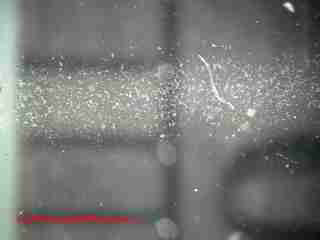
End-Shape of Air Sampling Cassette Particle Trace Patterns
An Air-O-Cell particle trace end shape is shown above, and the Allergenco-D particle trace end shape is just beloiw. Enlarging these trace patterns it appears that in this example the Air-O-Cell trace pattern end was a bit more square and sharply defined - a result that may vary from sample to sample.
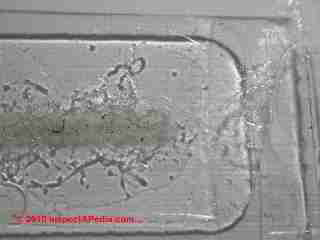
Below are closeup photographs taken in our dissecting microscope of the particle trace ends
Above is the Allergenco-D particle trace and below, the Air-O-Cell particle trace.
There is similar particle scatter at the ends of both traces. [The images are not identically magnified in these photos.]

Air Sampling Cassette Capture Media Consistency
One of our test sample pairs found that the Allergenco-D particle capture media had included voids that caused uneven particle capture across the trace (photo below-left). The Air-O-Cell media performed more consistently (photo below-right). Because of the possibility of a handling or preparation error we did not conclude that this trace inconsistency was a recurrent problem with either device. Further testing or reports of independent study of this question are needed.
Note, courtesy of EMS: An academic study by Grinshpun et alhas been published (see our references below) and found both in laboratory and field experiments that the Allergenco-D cassette exhibited better collection on smaller spores and more consistent results than the Air-O-Cell Cassettes.
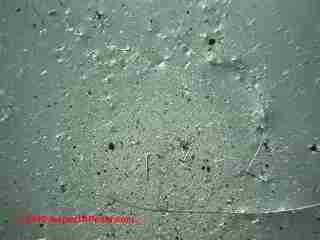
Air Sampling Cassettes and Media Shelf Life

Watch out: be sure to note and comply with the expiration date on these or any other biological or particle sampling supplies such as air sampling cassettes.
Because the particle-adhering media on the micro slides in air sampling cassettes may become dry with age, its ability to capture particles at its stated efficiency rate can be compromised, leading to significant errors in characterization of the level of particles in the air sample if you use the device after its expiration date.
The expiration date of the Allergenco-D sampling cassette is visible in our photograph (left)
Air-O-Cell recalled air sampling cassettes manufactured between July and December 2008 due to a change in the plastic housing, a related media dryout, and therefore an error in the anticipated expiration date of those particular products.
Concluding Comments on Air Sampling Cassette Consistency & Performance
It appears that both of these air or dust and particle sampling cassettes perform very well in the field and in the laboratory. The variations in quantitative analysis results such as spore counts between air samples appear to be dominated by factors other than cassette design or coated slide collection media.
This article is the first of two discussions on variability in air sampling cassette test results and particle trace patterns.
This article describes and present photographs of measurements of particle traces produced by the Air-O-Cell® and Allergenco-D® sampling cassettes when air samples using the two cassettes were collected simultaneously.
A separate quantitative analysis reporting and comparing actual particle counts forms part two of this topic and remains to be completed. Those results will also be provided here.
Watch out: OPINION: for marketing and legal reasons most aerobiology and mold test laboratories are willing to provide very precise spore-counts or particle counts obtained by partial or full particle trace analysis of air samples.
But as we explain at AIRBORNE PARTICLE COUNT VARIATION CAUSES, the variability of indoor air sample particle capture rates is enormous, at least several orders of magnitude, depending on factors that are virtually never managed, nor even recorded by most field investigators.
As a result, indoor airborne particle counts may be very precise (11,248 X-spores per liter of air) but very inaccurate or even dead wrong (off by three orders of magnitude from what occupants actually experience as their personal exposure). Do not confuse measurement precision with measurement accuracy.
Airborne Particle Sampling Research & Cassette SOPs
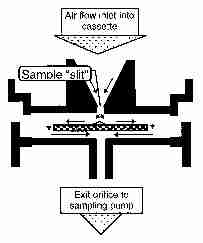
- [1] Air-O-Cell® Air Sampling Cassettes are sold to trap airborne particulates for quantitative analysis of airborne mold, pollen, house dust, allergenic particles, insect fragments, fibers, etc. Air-O-Cell® products are produced and sold by Zefon International, Zefon International, Inc., 5350 SW 1st Lane, Ocala, FL 34474, Telephone: 800-282-0073 or by website: http://www.zefon.com/store/
Zefon, at zefon.com/store/air-o-cell-sampling-cassette.html [web search 06/28/2010], describes the product as follows:
The Air-O-Cell® is a unique air sampling cassette specifically designed for the rapid collection of a wide range of airborne aerosols including mold spores, pollen, insect parts, skin cell fragments, fibers (e.g. asbestos, fiberglass, cellulose, clothing fibers, etc.) and inorganic particulate e.g. ceramic, fly ash, copy toner, etc.). The Air-O-Cell® collects both viable and non-viable sample specimens, providing a much broader overview of potential allergens contaminants than conventional sampling techniques.
The Air-O-Cell® operates upon the principle of inertal impaction. Particulate laden air is accelerated as it is drawn through the cassettes tapered inlet slit and directed towards a small slide containing the collection media, where the particles become impacted, and the air flow continues out the exit orfice.
The adhesive nature of the collection media prevents the collected particulate from blurring or being washed off during the laboratory staining process, and eliminates sample loss from vibration during handling and shipment.
After sampling is completed, the cassettes are sent to a laboratory, where the slides are removed and direct microscopic analysis can be immediately performed. The collection media is compatible with a wide range of biological stains and refractive index oils, allowing direct quantitative analysis of organic and inorganic particulate.
The Air-O-Cell® can be used with any standard off-the-shelf area sampling pump capable of drawing 15 LPM open flow. The small compact size makes Air-O-Cell® suitable for use in confined or restrictive spaces. - [2 Air-O-Cell] Air-O-Cell SAMPLING GUIDE [PDF] EMSL - web search 06/29/2010, original source: http://www.emsltesting.com/air-o-cell_cassette_sampling_g.html
- [2 Allergenco] Allergenco-D® Air Sampling Cassettes are distributed by EMS Sales, Telephone: 800-293-3003 or by website
http://www.emssales.net
Allergenco-D® Air Sampling Cassettes are used to trap airborne particulates for quantitative analysis of airborne mold, pollen, house dust, allergenic particles, insect fragments, fibers, etc.
The cassettes use a patented laminar-flow venturi to provide a high collection efficiency (low rate of particle loss) (d50=1.7um) and a well-defined particle trace.
Allergenco-D® Air Sampling Cassettes are sold to indoor air quality investigators, industrial hygienists, aerobiologists and other professionals from several sources including Environmental Monitoring Systems, Inc., 3864 Leeds Ave., Charleston SC 29405. See emssales.net
According to EMS,
"Peer reviewed study by the University of Cincinnati's Environmental Health Foundation confirms Allergenco-D’s design provides superior results! "
Here is EMS Sales product brochure for the Allergenco-D® Air Sampling Cassette -
http://www.emssales.net/uploads/allergencodtrifoldcomplete.pdf - [3] Thanks to Dr. James R. Tucker, PhD., COO & VP Technology, EMS Environmental Monitoring Systems, 3864 Leeds Ave., Charleston SC 29405, for technical review and comments - July 2010.
- [4] ANALYTICAL METHOD FOR QUALITATIVE MICROBIAL ANALYSIS OF ALLERGENCOD™ BIOAEROSOL SAMPLING IMPACTORS [PDF] James R. Tucker, PhD., Environmental Monitoring Systems, Inc., 164 Ashley Ave., Charleston SC 29402, 2005 - Web Search 06/29/2010 original source http://www.emssales.net/uploads/sop%20forallergencod.pdf
- [5] ASTM Method D7391-09 Standard Test Method for Categorization and Quantification of Airborne Fungal Structures in an Inertial Impaction Sample by Optical Microscopy
- [6] US EPA, PARTICULATE MATTER SAMPLING [PDF] ATPI 435: Atmospheric Sampling Course, U.S. EPA, retrieved 9/9/12, original source: epa.gov/apti/Materials/APTI 435 student/Student Manual/Chapter_4_noTOC-cover_MRpf.pdf
- [7] Fifth Kingdom, Bryce Kendrick, ISBN13: 9781585100224, - we recommend the CD-ROM version of this book.
This 3rd/edition is a compact but comprehensive encyclopedia of all things mycological. Every aspect of the fungi, from aflatoxin to zppspores, with an accessible blend of verve and wit. The 24 chapters are filled with up-to-date information of classification, yeast, lichens, spore dispersal, allergies, ecology, genetics, plant pathology, predatory fungi, biological control, mutualistic symbioses with animals and plants, fungi as food, food spoilage and mycotoxins. - [8] Fungi, Identifying Filamentous, A Clinical Laboratory Handbook, Guy St-
- [9] US EPA: Mold Remediation in Schools and Commercial Building [Copy on file at /sickhouse/EPA_Mold_Remediation_in_Schools.pdf ] - US EPA
- [10] Mycology, Fundamentals of Diagnostic, Fran Fisher, Norma B. Cook, W.B. Saunders Co. 1998, ISBN 0-7216-5006-6
- [11] McCrone Research Institute, 2820 South Michigan Avenue, Chicago, IL 60616-3292, Tel: 312-842-7100 Fax 312-842-1078, www.mcri.org
- [12] Sergey A.Grinshpun, Atin Adhikari, Seung-Hyun Cho, Ki-Yon Kim, Taekhee Lee, & Tina Reponen, "A small change in the design of a slit bioaerosol impactor significantly improves its collection characteristics",
Sergey A. Grinshpun, J. Environ. Monit., 2007, DOI: 10.1039/b702743e
This study, appearing in the Journal of Environmental Monitoring in 2007 and abstracted in our next citation [below] discusses a review comparing the Allergenco-D and Air-O-Cell impaction sampling cassettes, and describes an improvement in collection efficiency achieved by using an ultra-low jet-to-plate distance in the Allergenco-D sampling cassette.
A copy of the complete study (also see the next reference, below) is available from Environmental Monitoring Systems - emssales.net, Telephone: 800-293-3003 or by the company's website - emssales.net
The study's conclusion and acknowledgements include these comments:
This study revealed that a relatively small change in the bioaerosol impactor design (often regarded as of minor importance) results in a significant improvement of its collection characteristics, decreasing the cut-off size to the extent that the spores of practically all fungal species are efficiently collected on the substrate.
With respect to microscopic analysis, the spore enumeration data obtained using the three tested counting methodologies - the entire impaction trace count, 40-field partial count, and 20-traverse partial count - are statistically the same.
The study was partially supported by the Korea Research Foundation (post-doctoral fellowship for Dr. Ki-Youn Kim) and by the Environmental Monitoring Systems Inc. ... Reference to any companies or specific commercial products does not constitute or imply their endorsement, recommendation or favoring by the authors or by the University of Cincinnati. - [13] S.A. Grinshpun1 A. Adhikari1, S.H. Cho1, T. Reponen1, G. Mainelis2, M. Yao2, "Factors affecting the performance of bioaerosol impactors", European Aerosol Conference 2007, Salzburg,
T04A004 Web search 06/29/2010, original source: http://www.gaef.de/EAC2007/EAC2007abstracts/T04Abstractpdf/T04A004.pdf -
1 Center for Health-Related Aerosol Studies, University of Cincinnati, Cincinnati, OH 45267, USA
2 Department of Environmental Sciences, Rutgers University, New Brunswick, NJ 08901 USA Keywords: bioaerosols, collection efficiency, inertial impactor, cut-off diameter, particle deposition.
Abstract:
While different principles are utilized for sampling biological aerosol particles, impaction appears to be the most common for collecting bacteria and fungi. This method is used for total and culture-based microbial enumeration.
For instance, the total number of viable and non-viable airborne spores is conventionally counted under a microscope after collecting them on a slide of a single-stage impactor, e.g., Air-O-Cell sampling cassette (Zefon Analytical Instruments, Inc., USA), the Burkard Personal Volumetric Air Sampler (Burkard Manufacturing Co. Ltd., U.K.) and Allergenco-D (Environmental Monitoring Systems, Inc., USA) to mention a few.
Available bioaerosol impactors are usually equipped with either circular or rectangular (slit) inlets. Some impactors have a single nozzle as an inlet, e.g., Air-O-Cell, while others have hundreds of nozzles, e.g., Millipore Air Tester (Millipore Corp., USA).
More importantly, they differ from one another with respect to their ability to efficiently collect bio-particles of specific sizes as well as by the particle deposit uniformity on a substrate (the latter is often critical for applying certain microbial enumeration protocols).
The collection efficiency is characterized by the cut-off size, d50 that depends on the flow velocity through the nozzle, nozzle size (W), nozzle shape, non-dimensional jet-to-plate distance (S/W), and other factors. In this study, we have tested the physical performance of eleven bioaerosol impactors.
The collection efficiency and the bio-particle deposit characteristics were determined in the laboratory using a real-time particle size selective aerosol spectrometer and different microscopic enumeration methods.
The test impactors were challenged with non-biological polydisperse NaCl aerosol, monodisperse polystyrene latex (PSL) particles, and aerosolized bacterial and fungal spores (Bacillus subtilis, Cladosporium cladosporioides, Aspergillus versicolor, and Penicillium melinii).
The total number of spores, NMICROSCOPE, collected on the slide deposition area, ADEP, was counted and then related to the number of aerosol particles of a specific size range recorded by an aerosol spectrometer (Model 1.108, Grimm Technologies, Inc., Germany) upstream of the impactor over the time t. Thus, the actual collection efficiency of some of the tested impactors was calculated as [formula - see original source]
%100×=tQUPCMICROSCOPENACTUALE
Where CUP is the upstream aerosol concentration and Q is the sampling flow rate. The overall physical collection efficiency was also determined for biological and non-biological particles from the ratio of the aerosol concentration up- and downstream of the impactor. Consequently, d50 was obtained for each tested impactor as presented in the table below.
[Table - see original source]
Design and collection characteristics of the tested impactors. Impactor Jet shape No of jets Q, l/min W, mm S/W d50, μm Air-O-Cell slit 1 15 1.0 1.0 2.5 Allergenco-D slit 1 15 1.0 0.89 1.7
Burkard slit 1 10 1.0 1.0 2.4 CyClex round 1 20 4.4 0.1 1.8 Micro-5 round 1 5 2.1 0.12 ≤1 SMA round 12 141.5 6.3 0.8 4.8 BioCulture round 380 120 2.3 0.75 7 MAS-100 round 400 100 0.7 4 1.7
Microflow round 378 120 2.5 0.84 8.8 SAS Super 180 round 401 180 0.8 2.7 2.1 Millipore Air Tester round 1000 140 0.46 12.7 2.3
The data demonstrate how much the samplers differ by the cut-off size (d50 varies within a decade).
Some impactors appear to significantly undersample airborne fungi, and almost all of the tested samplers have clear limitations to efficiently collect bacteria. Statistical modeling was applied to determine the role of different impactor design parameters in the bioaerosol collection and enumeration process.
The study revealed that a relatively small change in the bioaerosol impactor design (e.g., Allergenco-D versus Air-O-Cell) may significantly improve its collection characteristics, decreasing the cut-off size so that practically all fungal species are collected on the substrate.
The dimensionless jet-to-plate distance was confirmed to be influential for reducing the d50 of single-nozzle impactors. For some multi-nozzle impactors, we found that the collection efficiency is improved substantially if S is decreased by increasing the amount of agar on the collection plate.
As to the microscopic enumeration of spores, the deposit uniformity and the count variability differ considerably from one sampler to the other. For several impactors, however, we found that the three methodologies – the entire impaction trace count, 40-field random partial count, and 20-traverses partial count – produced the same results (p>0.05). - [14] "Allergenco Air Sampler MK3 Owner's Manual and User's Guide", Allergenco/Blewstone Press, 999 E. Basse Rd. Ste 180, San Antonio TX 78298-1854 [Obs]
- [15] "Operating Instructions, Personal Volumetric Air Sampler for Glass Slides", Burkard Manufacturing Co., Ltd., Woodstock Hill Industrial Estate, Rickmansworth Hertfordshire WD3 IP, Great Britain Tel 01923 773134/5
- [16] Daniel M. Baxter, "A New Screening Method for the Evaluation of Indoor Bioaerosols & Airborne Dust Contaminants", Environmental Test Associates, 5290 Soledad Rd., San Diego CA 92109 Tel: 619-272-7747, November 1998 (Draft, pre-publication)
- [17] Daniel M. Baxter,1 Jimmy L. Perkins,2 Charles R. McGhee,2 and James M. Seltzer3"A Regional Comparison of Mold Spore Concentrations
Outdoors and Inside “Clean” and “Mold Contaminated”
Southern California buildings", Journal of Occupational and Environmental Hygiene, 2: 8–18
ISSN: 1545-9624 print / 1545-9632 online
Web search 06/29/2010 - original source: ncbi.nlm.nih.gov/pubmed/15764519 and jmsmd.net/images/Airborne_Mold_Interp.pdf
1 Environmental Analysis Associates Inc., and Indoor Analytical Laboratories, Inc., San Diego, California
2 University of Texas Health Science Center at Houston, School of Public Health, Regional Campus at San Antonio, San Antonio, Texas
3 University of California, Irvine College of Medicine, Indoor Environmental Monitoring, Inc., San Diego, California
Abstract:
A total of 625 buildings and outdoor locations in the San Diego, California, area were monitored using the Allergenco Sampl-Air MK-3 impaction sampler or the Zefon Air-O-Cell slit bioaerosol cassette.
Locations were classified by rigid criteria as clean commercial, commercial with mold growth, clean residential, residential with water staining, and residential with mold growth. In addition, coastal and inland outdoor locations were measured. S
even categories (total spores, Ascospores/ Basidiospores, Cladosporium, Smut/Myxomycetes like, Aspergillus/Penicillium (AS/PE), Alternaria, and Unidentified/ Other) were detected frequently enough that maximum likelihood estimate techniques could be used to determine distribution parameters and, thus, treat these as continuous variables.
For total counts (no nondetectables) an analysis of variance was used to examine differences in location means. For the other categories Land’s confidence limits were generated and visually compared for differences among locations.
For 12 other categories (Curvularia, Dreschlera, Epicoccum, Fusarium, Mildew-like, Pithomyces, Rusts, Stachybotrys, Stemphyllium, Torula, Ulocladium, and Zygomycetes-like), detection generally occurred in less than 10% of samples. These genera were treated as dichotomous (detect/nondetect) data, and Chi-square analyses differentiated between locations.
For total counts, values were significantly different on the order of clean < outdoor < moldy. There was a large difference between the moldy and other location classes. For
AS/PE, moldy location means were clearly higher than those for clean buildings and outdoors, although the clean and outdoor means could not be differentiated. For all other genera the results tend to indicate little or no ability to discriminate location.
For example, there were no differences in the probabilities of detecting Stachybotrys among the various locations. In our study only total counts, usually driven by AS/PE concentrations, had value in determining whether a building is mold contaminated employing our set of rigorous location classification criteria. - Keywords mold, comparison, airborne
...
Reader Comments, Questions & Answers About The Article Above
Below you will find questions and answers previously posted on this page at its page bottom reader comment box.
Reader Q&A - also see RECOMMENDED ARTICLES & FAQs
Question:
(Dec 21, 2011) Mold Man said:
Not surprised that the research study cited, Grinshpun et al, was funded by EMS. Shocking!!
Reply:
Mold Man - could you clarify your concern a bit? If you are referring to the air sampling cassette study that we describe above, with the exception of the donation of some test canisters themselves, a trivial item, the study was entirely independent, and funded by ourselves. We did not accept a dime from anyone.
We are dedicated to making our information as accurate, complete, useful, and unbiased as possible: we very much welcome critique, questions, or content suggestions for our web articles. Working together and exchanging information makes us better informed than any individual can be working alone.
InspectAPedia is an independent publisher of building, environmental, and forensic inspection, diagnosis, and repair information provided free to the public - we have no business nor financial connection with any manufacturer or service provider discussed at our website.
(Jan 10, 2012) Mold Man said:
DJF - I was referring to the Grinshpun study, not the one performed by InspectAPedia.
Question:
(Jan 9, 2012) Stephen Powell said:
Having spent almost 15 years in the enviromental testing field (some years ago) its nice to read and see what I always knew in that "experts" and consultants presenting spore trap results really dont have a clue as to the validity of their sample acquisition methods.
Reply:
Stephen, thank you for your comment. In my OPINON, whenever there has been a new surge of consumer fear (search InspectAPedia for "Enviroscare") such as UFFI, Asbestos, Radon, Mold, there has been a concomitant surge in a second tier of folks who jump onto the money train to profit while they can. One director of a major national test kit lab called me breathless with excitement about the prospect of "getting rich off of the mold ... the new 'radon'".
When we see a surge of consumer worry and a surge of additional people offering services to assuage those fears, it's no surprise that some (certainly not all) of the newbies are not well informed or well trained about the methodology, hazards, or in short, the science.
I should add that having the luck of operating a forensic lab as well as performing field work, I've been able to conduct some informative experiments that would be too costly (and not even ethical) for a regular field investigator to make. On the other hand, testing, without inspecting, is not diagnostic and not very helpful, and therefore often inappropriately priced for the consumer.
...
Continue reading at MOLD CULTURE TEST KIT VALIDITY or select a topic from the closely-related articles below, or see the complete ARTICLE INDEX.
Or see these
Recommended Articles
- ACCURACY OF AIR TESTS for MOLD
- ACCURACY vs PRECISION of MEASUREMENTS.
- AIRBORNE PARTICLE COUNT VARIATION CAUSES
- DUST SAMPLING PROCEDURE and see TAPE & BULK SAMPLING & TESTS for MOLD
- MOLD TEST vs. PROBLEM DIAGNOSIS
- SWAB & PCR SAMPLING & TESTS for MOLD
- VACUUM CASSETTE FILTER SAMPLE TESTS for DUST / MOLD
Suggested citation for this web page
at InspectApedia.com - online encyclopedia of building &
environmental inspection, testing, diagnosis, repair, & problem prevention advice.
Or see this
INDEX to RELATED ARTICLES: ARTICLE INDEX to MOLD CONTAMINATION & REMEDIATION
Or use the SEARCH BOX found below to Ask a Question or Search InspectApedia
Ask a Question or Search InspectApedia
Try the search box just below, or if you prefer, post a question or comment in the Comments box below and we will respond promptly.
Search the InspectApedia website
Note: appearance of your Comment below may be delayed: if your comment contains an image, photograph, web link, or text that looks to the software as if it might be a web link, your posting will appear after it has been approved by a moderator. Apologies for the delay.
Only one image can be added per comment but you can post as many comments, and therefore images, as you like.
You will not receive a notification when a response to your question has been posted.
Please bookmark this page to make it easy for you to check back for our response.
IF above you see "Comment Form is loading comments..." then COMMENT BOX - countable.ca / bawkbox.com IS NOT WORKING.
In any case you are welcome to send an email directly to us at InspectApedia.com at editor@inspectApedia.com
We'll reply to you directly. Please help us help you by noting, in your email, the URL of the InspectApedia page where you wanted to comment.
Citations & References
In addition to any citations in the article above, a full list is available on request.
- In addition to citations & references found in this article, see the research citations given at the end of the related articles found at our suggested
CONTINUE READING or RECOMMENDED ARTICLES.
- Carson, Dunlop & Associates Ltd., 120 Carlton Street Suite 407, Toronto ON M5A 4K2. Tel: (416) 964-9415 1-800-268-7070 Email: info@carsondunlop.com. Alan Carson is a past president of ASHI, the American Society of Home Inspectors.
Thanks to Alan Carson and Bob Dunlop, for permission for InspectAPedia to use text excerpts from The HOME REFERENCE BOOK - the Encyclopedia of Homes and to use illustrations from The ILLUSTRATED HOME .
Carson Dunlop Associates provides extensive home inspection education and report writing material. In gratitude we provide links to tsome Carson Dunlop Associates products and services.



